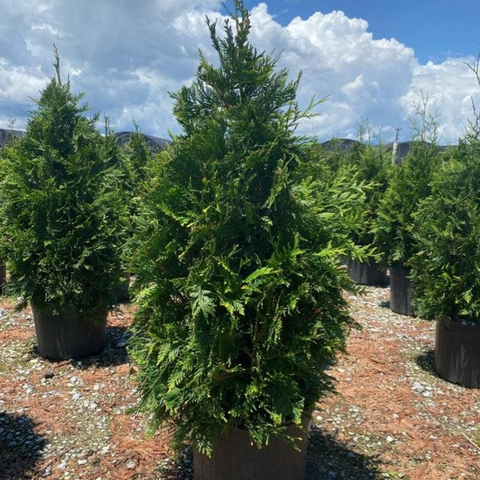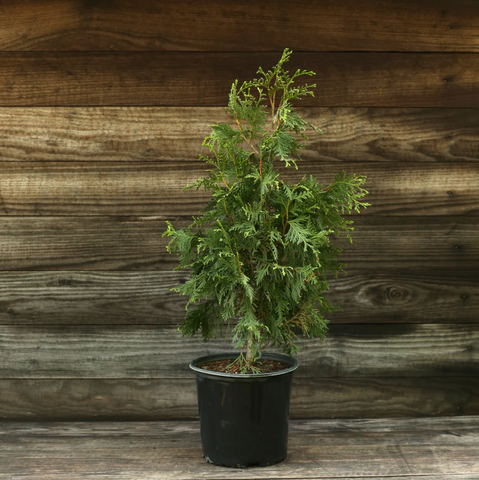Planting and Caring for Thuja ‘Green Giant’ Arborvitae
If you are looking for a versatile and durable evergreen that can enhance your southern landscape, Monrovia’s Green Giant Arborvitae may be the perfect choice for you. This fast-growing coniferous tree has become increasingly popular among homeowners and landscapers in the north-central Georgia region due to its stunning appearance, low-maintenance requirements, and adaptability to different soils and climates.
In this article, we will guide you through the essential steps for planting and caring for Green Giant Arborvitae, so you can enjoy its beauty and benefits for years to come.
Understanding Green Giant Arborvitae

IMAGES: Servescape, Green Giant Arborvitae
Characteristics of Green Giant Arborvitae
Green Giant Arborvitae, or simply Green Giant, is a hybrid cultivar resulting from the cross-breeding of the Western redcedar (Thuja Plicata) and the Japanese Arborvitae (Thuja Standishii). The tree can reach a height of up to 40-60 feet with a spread of 12 to 18 feet, making it an excellent choice for creating natural screens or windbreaks in large properties.
The foliage of Green Giant is dense, lush, and resists browning and shedding even in winter, which contributes to its attractiveness and privacy value. Green Giant is also resistant to many pests and diseases, including deer, which makes it an ideal choice for areas with wildlife.
Ideal Growing Conditions
Green Giant Arborvitae thrives in full sun to partial shade, although it prefers exposure to at least six hours of sunlight per day for optimal growth and vitality. This tree is tolerant of a wide range of soils, including loamy, sandy, and clay soils, as long as they are well-drained.
Poorly drained soils can cause root rot and other problems, so it's crucial to avoid planting Green Giant in areas with standing water or compacted soil. Green Giant can also adapt to different pH levels and soil types, but adding organic matter such as compost or peat moss can help improve soil quality and fertility.
Avoid planting Green Giant near concrete or other impervious surfaces to prevent root restriction and water runoff.
Planting Thuja Green Giant Arborvitae
Choosing the Right Location
Before planting your Green Giant Arborvitae, you should carefully select the best spot in your landscape that meets its growing requirements and your landscaping goals. Green Giant works well as a specimen tree, a hedge, or a windbreak depending on how you space and prune it.
If you plan to use Green Giant as a privacy screen or natural fence, then plant it in a row spaced at least 10 feet apart to allow for maximum growth and coverage. Avoid planting Green Giant too close to buildings, power lines, or other structures that can interfere with its height and spread.
Preparing the Soil
The next step in planting Green Giant is preparing the soil. Start by removing all weeds, grass or other debris from the planting site. Then, use a shovel or a tiller to loosen the soil to a depth of at least 12 inches. Break up any clumps of dirt and remove any rocks, sticks, or other debris that can interfere with root growth.
Test the soil pH and nutrient levels using a soil test kit, and adjust them according to the recommendations of the kit or a local extension office. Adding a slow-release fertilizer such as 10-10-10 or 15-15-15 can help provide essential nutrients for Green Giant during its initial growth stages.
Planting Steps and Techniques
Once the soil preparation is completed, it's time to plant your Green Giant Arborvitae. Follow these steps for the best results:
- Dig a hole that is twice as wide and equally deep as the root ball of the young tree.
- Lower the root ball into the hole, making sure that the top of the root ball is level with the soil line.
- Backfill the hole with the soil mixture, tamping it gently around the roots to eliminate air pockets.
- Water the newly planted tree thoroughly to saturate the roots and settle the soil.
- Apply a layer of mulch, such as wood chips or shredded bark, around the base of the tree, leaving at least a few inches of clearance around the trunk to prevent moisture retention and pest damage.
Spacing and Arrangement Tips
To create a well-spaced and attractive screen or hedge, it's essential to consider the mature sizes and shapes of Green Giant Arborvitae. Space the trees 10 to 12 feet apart between rows and 4 to 6 feet apart within rows for optimal growth and coverage. You can also vary the spacing based on your preferences and the landscape's needs.
For example, you can plant them closer together to achieve a dense barrier or leave more space between them to create a more open feel. Use stakes and strings to mark the planting locations before digging to ensure the trees are lined up straight and evenly spaced.
Caring for Thuja Green Giant Arborvitae

Watering Requirements and Techniques
Green Giant Arborvitae has moderate water needs and can tolerate periodic droughts as long as it's established. However, regular watering during its first year after planting or during hot and dry spells can help promote healthy growth and prevent stress.
Water the tree deeply and infrequently, applying 1 inch of water per week or more during extremely dry periods. To avoid over-watering or under-watering, check the soil moisture level regularly by sticking your finger into the soil at a depth of at least 3 inches. If the soil feels dry, it's time to water.
Fertilizing Your Arborvitae
Green Giant Arborvitae is not a heavy feeder, but it can benefit from a nutrient boost from time to time. Fertilize your tree once a year in late winter or early spring before new growth begins or in fall after the tree sheds its needles.
Use a slow-release granular fertilizer that contains nitrogen, phosphorus, and potassium, such as 10-10-10 or 15-15-15. Apply the fertilizer according to the package directions, making sure to water the tree well after fertilization to allow the nutrients to penetrate the root zone.
Pruning and Shaping
Green Giant Arborvitae requires minimal pruning other than removing any dead, diseased, or broken branches as soon as you notice them. However, you can shape and trim your Green Giant to enhance its aesthetic appeal or control its size and shape if necessary.
Prune your tree in late winter or early spring before the new growth appears. Use sharp and clean pruning tools, such as hand pruners or loppers, to make clean cuts and avoid damaging the tree.
To shape a hedge or a screen, cut the sides of the tree to a slight angle to encourage dense growth and prevent bare patches. To control the height, cut the leader or central stem to the desired length and avoid topping the tree, which can lead to weak and uneven growth.
Pest and Disease Management
Green Giant Arborvitae is relatively pest and disease-resistant, but it's not immune to certain problems that can affect its health and appearance. Some common pests that can damage Green Giant include spider mites, bagworms, scales, and aphids.
Check your tree regularly for signs of infestations or damage, such as webbing, discoloration, or defoliation, and treat them with an appropriate insecticide or pesticide if necessary.
Some common diseases that can affect Green Giant include root rot, canker, and blight. Avoid overwatering or creating a moist environment near the trunk or branches, which can promote fungal growth. Prune any infected branches as soon as you notice them, and dispose of them appropriately to prevent spreading the disease.
Seasonal Care for Monrovia’s Green Giant Arborvitae

Preparing for Winter
Monrovia’s Green Giant Arborvitae is a hardy tree that can withstand most winter conditions without major issues. However, you can take some measures to prepare your tree for winter and ensure its health and vitality. Apply a layer of mulch around the base of the tree in fall to insulate the roots and conserve moisture.
Keep the area around the tree clean and free of debris, which can trap moisture and encourage pests and diseases. You can also wrap your tree with burlap or a frost cloth to protect it from wind and cold weather, especially if you recently planted it or live in an area with harsh winters.
Spring Maintenance
Spring is an active growing season for Green Giant Arborvitae, and it's an excellent time to check its health, remove any dead or damaged branches, and fertilize it. Inspect your tree carefully for signs of winter damage, such as broken branches or browning needles, and prune them promptly.
Apply a slow-release fertilizer around the drip line of the tree, making sure to water it well afterwards.
Summer Care Tips
Summer is when Green Giant Arborvitae reaches its peak growth and requires the most water. Water your tree deeply and regularly, especially during dry spells, but avoid overwatering, which can lead to root rot or other problems.
Check your tree for any signs of stress or pests, such as yellowing needles or webbing, and address them early to prevent further damage.
Fall Preparations
Fall is the ideal time to plant new Green Giant Arborvitae in your landscape, as the soil is still warm and the tree can establish its roots before winter. Choose healthy and well-rooted specimens, and plant them according to the steps and techniques discussed in this article.
Fall is also an excellent time to prune your existing tree, remove any dead, diseased, or crossing branches, and shape it as needed before winter. Avoid pruning too late in fall, as it can stimulate new growth that will be susceptible to winter damage.
By following these planting and caring tips, you can ensure the success and longevity of your Thuja Green Giant Arborvitae and enjoy its many benefits throughout the year. Whether you use it as a screen, a hedge, or a specimen, Monrovia’s Green Giant can enhance your landscape and provide privacy, beauty, and shelter for you and your family.

Click here if you’d like to purchase this plant.
If you need any advice or tricks/tips in creating the garden of your dreams, we are here to make those dreams come true! Connect with us here, or chat with us via the chat button on the bottom of any page on our website.
To create a landscape that gives you joy every time you walk out your door or look out your window, it’s important to have a design plan in place. Learn more about our elite Designer Marketplace platform, which allows you to select easily from a list of expert landscape designers, landscape architects, and more.
Click here to view more plants from the beautiful Monrovia® collection.













































